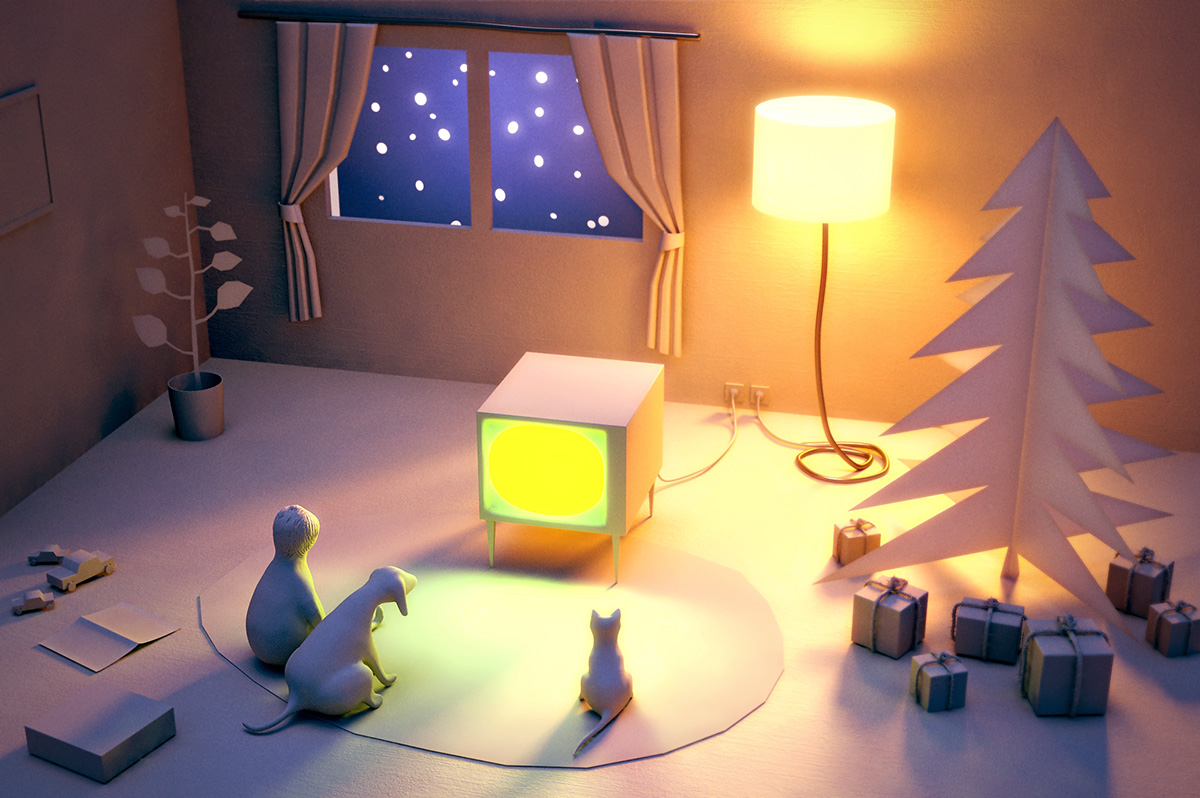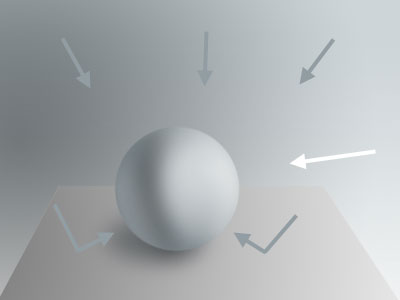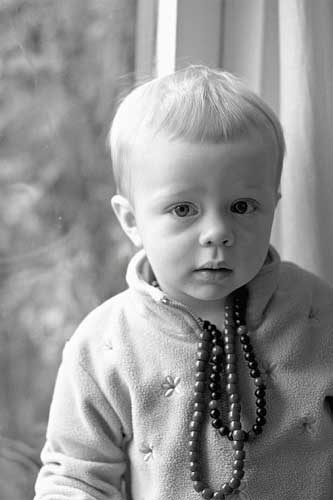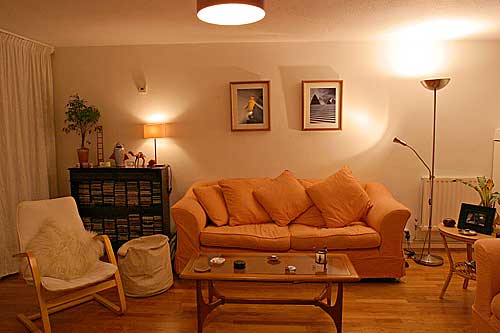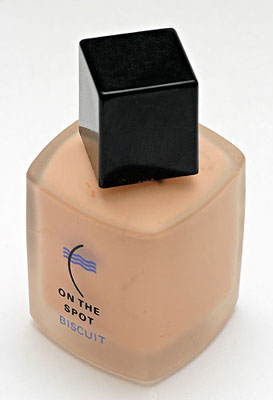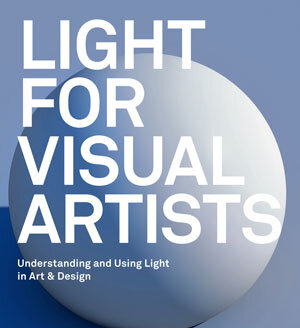Chapter 4 - Artificial and indoor lighting
Light indoors has a very different character to that found outside, mostly down to the lack of direct sunlight found indoors. With human beings in control of the light source there is an added twist in that the light is often designed for a specific purpose. For instance household lights are designed to give off appealing, generally diffused light whereas office lighting is more functional and cost-effectiveness is often the overriding concern - which is why office workers have to walk around in a green murk.
Most artificial lights indoors are diffused, that's the purpose of the lampshade, in order to soften the light and the shadows it produces. The major exception to this is spotlights, which produce hard lighting. However lighting designers will generally use multiple spotlights so that there isn't just one hard light but several which together will soften one another's shadows, yet still create a multitude of highlights.
Sunlight indoors is almost always diffused as it bounces between walls, floors and ceilings. Direct sunlight can get in through windows and skylights but because of the comparatively small size of windows in relation to walls much of our homes never comes under the light of the sun before it has been reflected by one surface or another.
Window light
Window light is how we generally see natural light indoors. Since the window itself is the effective light source this means that the light is quite soft (since a window is a large source). Window light is attractive and very photogenic. If there is only one window then contrast is relatively high despite the soft light source, with multiple windows contrast can be lower since there will be more fill light.
The colour of the light is dependent on many things: firstly the weather will affect the light coming through the window, if it is overcast the initial light will be white, grey or blue. In sunny conditions it will be either blue skylight or white, yellow or red sunlight (depending on time of day). Once the light comes through the window it will also be affected by the surfaces that it reflects from in the room. Wall, floor and furniture colours will all influence the light as it bounces around.
Obviously all these factors mean that to convincingly portray window light you will need to think very carefully about all the possible permutations and plan the strength, colour and contrast thoughtfully. The simplest set-up would be an overcast day with white light coming into a white room from one large window, you can then plan any permutations using this simple model as your starting point and vary it from there.
One very famous type of window light is called the North Light, essentially the light provided by a north-facing window. In the past artists didn't have reliable artificial lighting, and so by having a studio with a window that faced north it was possible to have a fairly constant and consistent light throughout the day. The reason of course being that the sun is always in the south (in the northern hemisphere at least), so only diffuse light from the sky would shine in through that window - soft light with no strong direction or shadows. The main qualities of the North Light are the same as any window light without direct sunlight. Although north-facing rooms are dark due to lack of sunlight the light is quite pleasing.
Although there is direct sunlight coming into this room it affects only a relatively small area. Most of the light on the walls and furniture is coming from a reflection of this sunlight or the diffuse light provided by the window itself. Notice the red colour on the far wall, which is probably a reflection from the curtains. Also note the high contrast that the sunlight creates, the highlight areas are very bright.
Here is an illustration of how soft the light from a window can be. The photo was taken in overcast weather and the window is acting like a giant softbox for this portrait. The closer the subject is to the window, the softer the light. If you're not sure what is meant by soft light this will be explained in Part 5, but for now notice how the edges of the shadows are blurred and the transitions between light and dark are softened.
The soft light that a large window provides has been used by artists for centuries (and is still often used by modern day photographers) because it is beautiful, predictable and readily available.
Household tungsten lighting
This is the most common form of indoor lighting we encounter on a day-to-day basis, it comes in many different forms from overhead bulbs to lamps and side lights and its common feature is that it uses incandescent bulbs.
The colour of tungsten lighting is a strong yellow/orange as demonstrated in part 1. This is because the light bulbs we use can be easily manufactured to emit this colour, and since our brains have the capacity to filter out the orange colour we perceive it as being white. Generally if you are photographing, drawing or painting a tungsten lit interior it is more realistic to depict the light as being whiter rather than more orange since our own perceptions should be used as the benchmark to follow, rather than absolute reality. Photos or drawings that look bright orange might in fact look less convincing despite being more accurate.
The quality of tungsten lighting however is far more varied and less predictable though, since there are many different approaches to lighting interiors. In ordinary households most lights will be diffused by the use of a lampshade, making the effective size of the source bigger and softening the light.
Lighting in your average house will vary from room to room, with the function of the space dictating the quality of the light. On the most basic level a room such as a utility room or a garage might have a single bare bulb, giving hard unattractive light. This would be acceptable in such a room because little time is spent there and so functionality will take precedence over aesthetics.
In a room where one might spend a lot of time, and where quality of light might be considered important in order to create a pleasant and comfortable atmosphere, you are likely to find a more complex and attractive lighting scheme. For instance in a sitting room (which might be the centrepiece of a home) you could find a large number of lights which are used together to create a pleasing ambience.
Function will also play an important part in other areas of a typical home, for instance in a bedroom you would expect to find bedside lights because they are convenient for bedtime reading or for getting up in the dark. In a kitchen you might find spotlights designed to light up the cooking area or work surfaces, and bathroom cabinets and mirrors might also have dedicated lighting for functional purposes.
Apart from in the most basic situations, most household lights will have a combination of function and light quality. The most common accessory to a household light is the lampshade, which however comes in many forms - all of which are designed to soften the light to some extent. A lampshade will hide the blinding glare of the bare bulb and soften the hard shadows created by the naked light source.
The next important element to consider is that the vast majority of interiors will use a number of light sources, which will further soften the light and shadows. The light from different rooms will spill over in to adjacent spaces and most rooms will have more than one light in them. Typical examples might be sitting rooms with four or five different lights used to create small pools of attractive light, or a modern kitchen which might have rows of recessed spotlights in the ceiling.
Multiple lights used in this manner will create uneven and interesting lighting across the room and will cast multiple shadows, often with different levels of hardness or softness. The other very obvious result of having a number of light sources is that reflective surfaces will have multiple highlights, one for every light. It is also possible that the lights will have subtly different colours and intensities from one another because bulbs get dimmer and redder as they get older.
Finally you should consider that certain other household devices can emit light, computers and televisions being the most obvious examples but there are also microwaves, cookers and a multitude of other items which might emit some light in a typical house.
As ever the only advice I can give is to study a number of interiors for yourself, since this subject is limited only by human imagination and there are infinite variations this theme.
This is a fairly typical interior with several lights used to create atmosphere, notice the various methods used to soften the light with lampshades and by bouncing the light off the wall. As a result of using a number of diffused lights in this manner there are no hard shadows. In this image I've tweaked the white balance to make it a lot less orange as the real colour of tungsten lighting doesn't look realistic, but using a mellower suggestion of orange looks quite convincing and conveys the colour we actually perceive ourselves.
Restaurants, shops and other commercially designed interiors:
As with ordinary household lights this kind of lighting is very varied and primarily used to create mood and direct the eye. In a lot of cases this lighting is designed with great care to create the desired effect so it should take some careful study to recreate what the designers have aimed for.
Restaurants generally have low, soft lights in numbers to create atmosphere. There might also be quite a mixture of different kinds of lights from spotlights to pick out the flowers on the table to candles on the tables themselves. Obviously no two restaurants will be the same so expect a great deal of variety from one place to the next. Observing restaurant lighting carefully is a great way to understand how mood and atmosphere can be created with interior lighting.
One important detail to note when recreating the atmospheric lighting you might find in a restaurant or bar is that the relatively large number of lights used will also create many reflected highlights - these will be visible in all reflective surfaces from cutlery and plates to people's eyes. As with household lighting the different sources will vary in colour and intensity, creating pools of light across a room.
Shops have different lighting needs, and although atmosphere is still important cost and good visibility are probably the main criteria. Most mainstream shops will be brightly lit with strip lights to create a bright and clear environment with maybe extra lighting to pick out specific displays. As ever if you are trying to recreate a specific environment it pays to think of the specific function the place fulfils before trying to recreate the lighting.
Obviously as before it goes without saying that this topic is vast and varied, and there is far more variety than I can ever hope to cover in an article of this scope. The best thing to do as ever is to make your own observations, and maybe take some photographs in various settings for reference.
This is a fairly typical (if colourful) restaurant with a multitude of lights used to create atmosphere. There is colour and visual interest everywhere and a lot of thought has gone into this fun space.
Here is a closer view, notice the high number of highlights in the glasses, they are reflections of all the different lights.
A typical shopping centre with bright lighting, I've colour corrected the image but the slight green tint from the lighting is still visible. Notice the multiple shadows under the chairs which come from multiple light fixtures.
Fluorescent lighting:
Fluorescent lights are primarily used in situations where cost is a factor, their colour temperature is usually greenish, and despite the fact that our brain can compensate for the white balance we still perceive the light as being quite ugly. This kind of lighting is commonly found in offices, stations, public buildings and anywhere that needs to be lit on the cheap.
Fluorescent lights are often used to light relatively large areas with many individual lights, meaning there will be complex overlapping shadows and multiple rectangular highlights. The density of lights will dictate the brightness of the lighting: settings such as shops using many lights to create a bright environment and more spartan spaces such as car parks using fewer and thus being darker.
This photo was taken with daylight balanced film under fluorescent strip lights, you can see the strong green cast that these lights have.
Mixed lighting:
Both indoors and outdoors it is very common to see a mixture of natural light and artificial light, especially at dusk and at night. This can lead to very interesting mixtures of colours and intensities, especially since natural light and tungsten light often have complimentary colours in blue and orange.
Any object near a window whose curtains aren't drawn in the evening or at night would have some mixture of natural and artificial light on it. This kind of lighting is obviously very commonly found outdoors too, for example things illuminated by street lights usually have some natural light as fill. Lights on buildings too can have very interesting colours and create striking contrasts with natural light coming from the sky.
I personally find mixed lighting very atmospheric and inspirational, and I use it frequently in my work because of its interesting visual appeal.
Mixed lighting can be used to create atmosphere and interesting colour schemes.
Here we can see how interesting colours are created by design in urban settings, with the warm lights on the Houses of Parliament probably designed to compliment the natural evening light.
Here the mixture of colours looks positively alien, with the green of fluorescent lights in the windows mixing with both tungsten light and skylight.
Firelight and candlelight:
Light that comes from a flame is even redder than incandescent light from light bulbs, in fact its colour temperature is so low that our brain can't compensate for it and we actually perceive it as orange or red.
The other important fact to consider with these kinds of light sources is that they are often placed much lower than incandescent lights: fires are usually at ground level and candles are placed on tables or other furniture, whereas bulbs most often light from above. This will have an obvious effect on everything from the way that light strikes various surfaces to shadow and highlight placement. Finally it is worth remembering that the light source is often moving as light from fire and candles flickers.
Candle light is very red, here I've toned down the actual colour temperature to make it look more natural. Our brain can't really compensate for colours that are so strong so we do perceive the light as being warm.
Street lighting:
Street lights are a deep orange (in the UK at least where I live), and they have a very narrow spectrum meaning that they can't show any other colours. This makes everything under them appear a very monochromatic orange.
In between two or more street lights objects will cast multiple shadows. Another thing to observe is that the pool of light underneath them is usually quite small, and fades into darkness quite quickly, making streets at night very high in contrast.
You can see how narrow the range of colours is under typical street lighting, everything except the grass is orange. The shadows point in various directions because of the multiple lights, and contrast is very high without any fill light. The sky behind the branches is also orange due to light pollution from the London street lighting.
Photographic light:
A full explanation of photographic lighting is far beyond the scope of this article, but I do want to mention it briefly, mostly so that photographic reference can be used wisely. Of course there are many types of lighting used in photography, but the most commonly found in portrait and product photographs is very soft light from a diffused flash.
This kind of light is easily recognised by the absence of shadows, so if your photographic reference features this sort of lighting you should take this into account and adapt it according to your own requirements. Of course this applies to any lighting found in reference material.
This soft shadowless light with broad highlights is typical of contemporary product and portrait photography, particularly in advertising. It is created with the use of very large softboxes, which act as large diffuse light sources.
Other kinds of light and special cases
Hopefully I have been able to outline most of the commonly occurring types of lighting. However my intention isn't really to create a guide for every possible situation but rather to encourage observation and understanding. It is so easy to take lighting for granted and not notice its behaviour even though we see it all around us all the time. In fact looking and noticing in the first place seems to be the hardest thing, it is actually quite easy to reach an understanding once this crucial first step has been taken.
So hopefully, with the knowledge gained from this article, it should be possible to work out how light behaves in other situations which aren't specifically explained here. For instance you may need to figure out how to light an underwater scene on a tropical reef. Where would the light come from? How would the light react in this environment? What colour would it be? How much reflection would there be? What about diffusion, clarity, shadows etc…
I really hope that readers will be able to use the information here as the launch pad for their own observations. Too often it is so easy to parrot clichés that are recounted without thought (3 point lighting being a prime example), and when so little quality information is available about light in the first place it leads to the same old tired formulas being repeated over and over. However with your eyes open it is possible to formulate your own thoughts and make your own original observations. This really is the purpose of my article.
